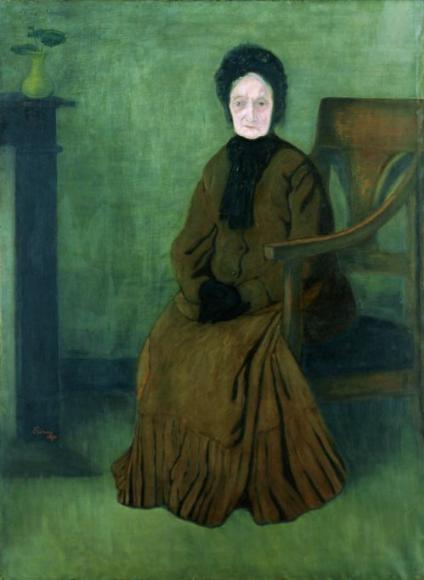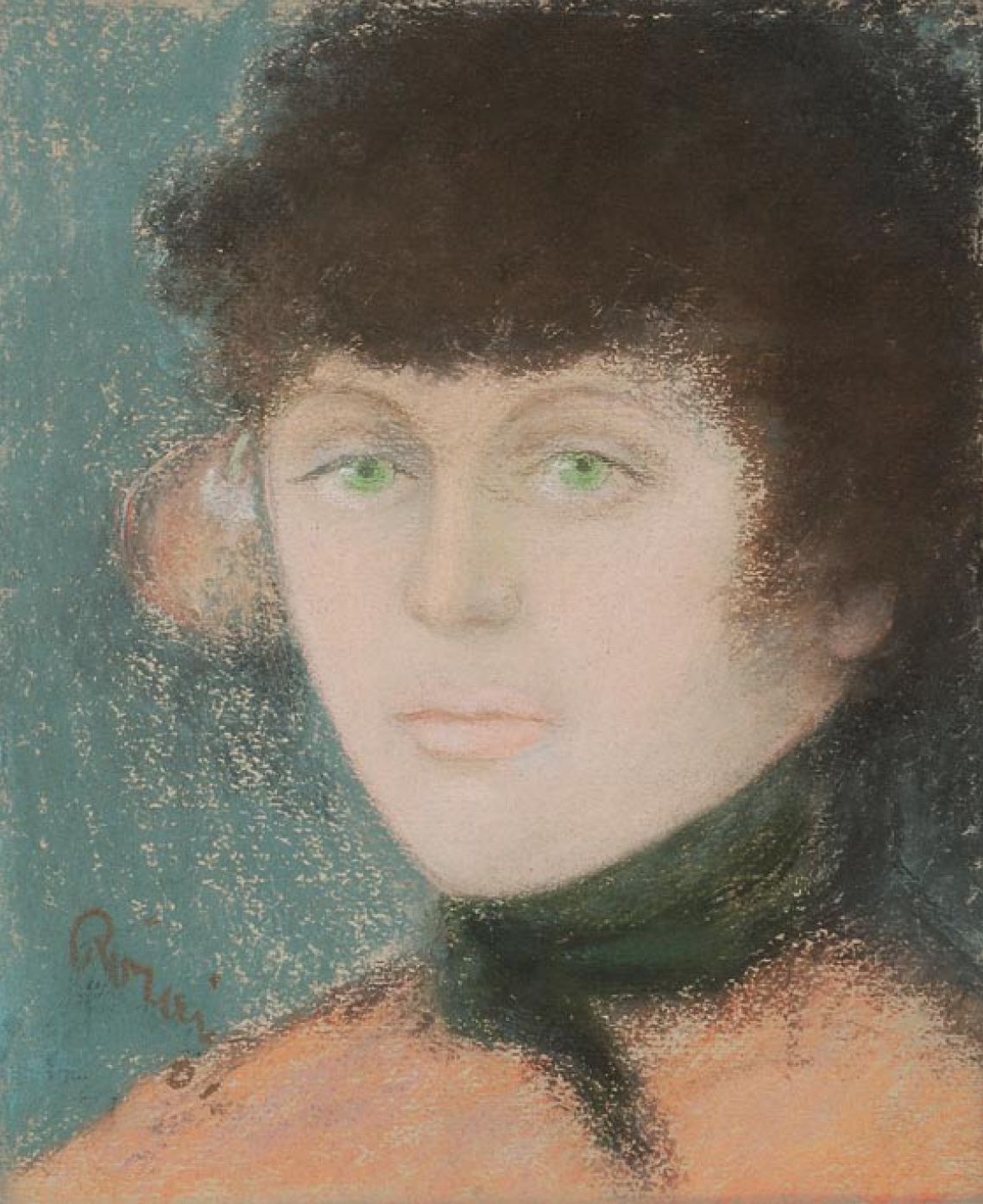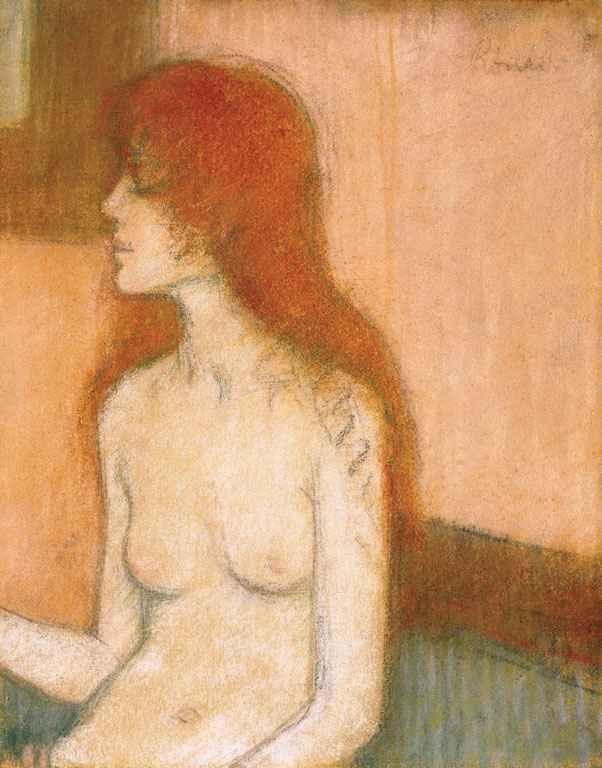József Rippl-Rónai is considered one of the finest Hungarian painters and yet his paintings in garish colours with flat treatment of the surface cease to keep me interested. I could see them and forget them in the matter of seconds. His pastel portraits, on the other hand, are absolutely captivating and they have a rare haunting beauty.
 József Rippl-Rónai, Woman’s Head with Red Bun, 1891
József Rippl-Rónai, Woman’s Head with Red Bun, 1891
József Rippl-Rónai was born in the town of Kaposvár in the southern Hungary on the 23 May 1861. He attended grammar school and later, most unusually for someone who would went on to become such a fine painter, studied pharmacology. From 1881 he worked in an apothecary in his home town and as a private tutor for the family of count Zichy. He only casually attended some drawing classes, and once in a while travelled to Vienna to copy the works of old masters. In 1884 he was awarded a scholarship to study art in Munich, at last! It was common for the aspiring artists from the Austro-Hungarian Monarchy to study in Munich, or, if fate dealt them better cards, even in Paris; the place where everything was.
Rippl-Rónai was among those lucky students and after just two years in Munich, he got the opportunity to study in Paris with a fellow Hungarian artist Mihály Munkácsy who painted realist style genre scenes and whose influence, thank the providence, would not have an impact on Rippl-Rónai’s art. After settling in the big bustling city of boulevards, tree avenues, cafes, city of light and hope, he moved to Neully and briefly studied in Academie Julien. In Paris he met a lady who was to be his future wife, Lazarine, and, even more importantly for his art, he met and befriended a few progressive artists, Édouard Vuillard and later Paul Gauguin as well. In 1894, after his painting “My Grandmother” was exhibited in Parisian Salon Champ-de-Mars, the art group Les Nabis recognised him as one of their own. From then on, his artistic career only blossomed.
 József Rippl-Rónai, My Grandmother, 1894
József Rippl-Rónai, My Grandmother, 1894
What amazes me is the fact that Rippl-Rónai’s well-known paintings are those influenced by Les Nabis, with flat space and bold colours, while his shadowy and ethereal pastel portraits are left in the shadow. A contemporary critic described his already mentioned painting “My Grandmother” as “a poem about the profound sadness of old age”, and he was very right in comparing it to a poem. All of Rippl-Rónai’s pastels have this quality of transcending the borders of arts; at times they reminds me of some Swinburne’s verses, at times they make me think of wistful violins in candle lit chambers. Undeniably, they posses a striking lyrical beauty and an eeriness that would interest even the great Edgar Allan Poe himself. Perhaps Rippl’s painting “Woman’s Head with Red Bun” shows the kind of face that Poe had in mind in his short story “The Oval Portrait”. They have a musical element about them, lyrical too, a string of a lyre, a soft hush of a violin, a fragrance of withering roses, delicacy of something passing and transitory, unearthly beauty, verses written in ink and slowly fading, these are the faces of women you see once, only for a moment, and spend your entire life fantasising about.
A little digression here. In his essay on Beethoven, E.T.A. Hoffmann, a German Romantic author, described music as “the most romantic of all arts, and we could almost say the only truly romantic one because its only subject is the infinite. Just as Orpheus’ lyre opened the gates of the underworld, music unlocks for mankind an unknown realm—a world with nothing in common with the surrounding outer world of the senses. Here we abandon definite feelings and surrender to an inexpressible longing…” Likewise, Rippl-Rónai’s pastel portraits stand on the border of different arts, soaked in music notes, whispering verses…

József Rippl-Rónai, Red-haired Parisian Girl, 1891, pastel
These pastels are something extraordinary in Rippl-Rónai’s oeuvre, the farthest he went from his Realist beginning, the closest he got to Symbolist tendencies, to aestheticism and l’art pour l’art philosophy of the late 19th century. In “Woman’s Head with Red Bun”, this delicate oval face seems to arise from darkness and appear in its smooth as ivory, pale as milk and moonlight colour just for the viewer. Distant, untouchable, delicate as a lily, she oozes fragility and gentleness, and soft perfumes and sounds of wistful violins, her lips are two rose petals, her large blue eyes, watery and soft even without the drops of belladonna, are two wells that reflect the languorous world of dreams. The transition between the strongly contrasting colours, black and white, are ever so soft, and give the appearance of something that is slowly vanishing, as if every time you blink and then open your eyes again she will be gone; she isn’t really here anyway, she is just passing through this material world without touching it, without being tainted by it.
Painting “Red-haired Parisian Girl” resides in an equally dreamy other-world as the previous maiden, but hers is the kind where you leave all your hopes before your enter. If the previous pastel showed a ghostly maiden, this one then is surely a lesbian vampire or a muse gone mad, laudanum addict, the face of Elizabeth Siddal from the other side of the grave. Distant gaze of those aqua blue eyes that also match the colour of the background are as eerie as they are fatal and inviting. Masses of her fiery red hair overwhelm the bounds of the canvas, There’s a certain masculinity in her face the strong jawline and neck, along with coppery hair, bring to mind Rossetti’s somnambulist femme fatales, beautiful and cruel, irresistible and cold. This is a face from a dandy’s opium dream.

József Rippl-Rónai, Lili Darvas Playing Lonti, 1922, pastel
The mystic shadowy beauty of these pastels reminds me of one poem in prose written by a Croatian Symbolist poet and writer Antun Gustav Matoš (1873-1914) called “Shadow”, these paintings, to me, seem to match Matoš’s lyrical dream-like visions:
“I love the mournful shadow, the dozing light: light which dreams of the night. I love the shadow, twin sister of the warm sun and of the cold moon. I love the shadow, my eternal adopted sister and companion which slumbers beside me, walks near me, my dark picture and my caricature. Yes, I love the shadow, yellow, grey, black; the shadow, sad and silent as death….
O, Shadow, child of the day and the night! Shadowy morning and purple evening! Shadow, child of darkness and light, pale daughter of enigma, opening melancholy silent weary eyes, and through them life peers wonderingly into mysterious death! Last night, my love, you were trembling against my breast with the moist eyes of affection and happiness. I named you beauty, happiness, and woman, but there remained a handful of ashes in place of honey. Love, you also are a shadow….
The shade told me, the shade which grew larger and larger behind the old oak beneath the moonlight whilst awaiting the dew and the dark song of the nightingale under the shrubbery of the hawthorne and brier rose, such shady, foggy and grey fables. The shade was whispering to me this morning as well, as it walked under the fleecy cloud across the field of stubble, caressing the larks’ and the quails’ nests, and kissing the quivering tops of the field flowers.
Shadow, thou soft pillow of light: Shadow, thou black bed of life! And when once the planets extinguish, you will remain the empress of life.
I love you, Shadow, pure silent goddess: lift up your soft mantle of fog streaked with golden secrets, and cover my weary eyes, to close them to embrace my shadow.” (Antun Gustav Matoš, Shadow)

József Rippl-Rónai, Woman with Red Hair, c. 1890s

József Rippl-Rónai, Green-Eyed Woman, 1901, pastel

József Rippl-Rónai, Girl on Blue Background, date unknown

József Rippl-Rónai, Sitting Nude with Red Hair, 1891, pastel

József Rippl-Rónai, Parisian Woman, 1891, oil on canvas


